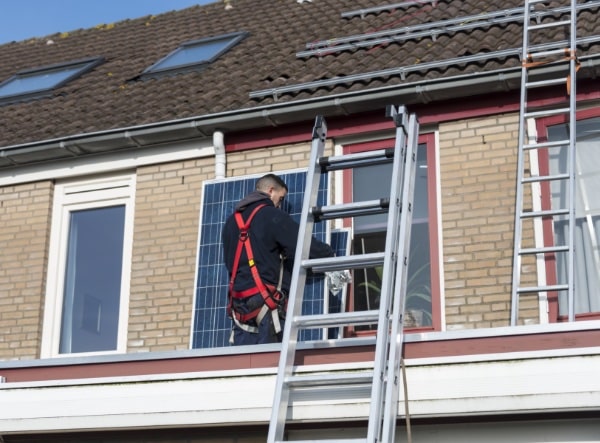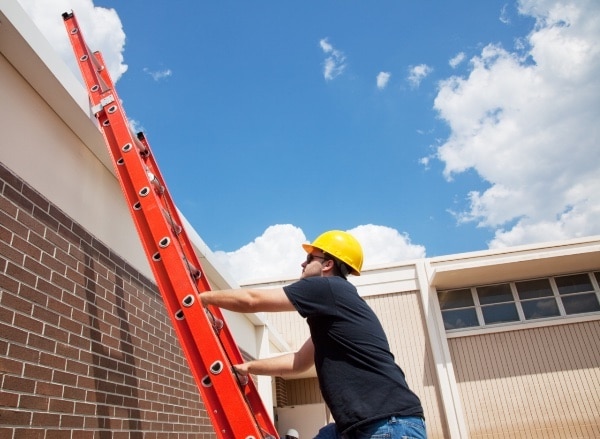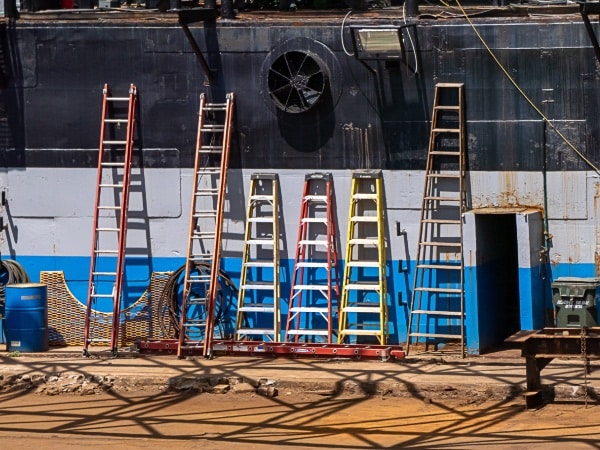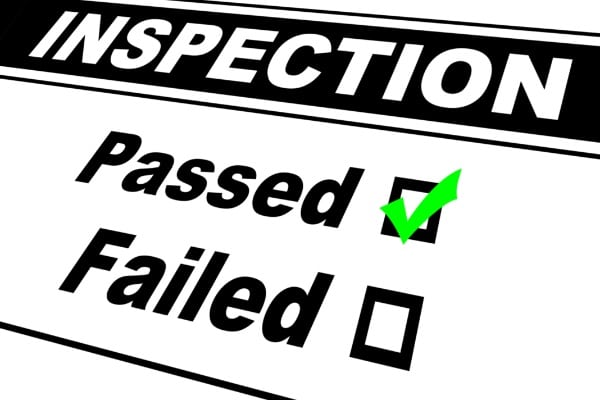How to Tie Off a Ladder for Safety – [Updated for 2023]

Preventing injuries is everything. Over the past decade, more weight has been put on increasing injury prevention in the building industry. Safer workers are happier, more productive, and more profitable. Due to their widespread use, and often unstable nature, ladders are a common cause of workplace injuries.
The Centers for Disease Control and Prevention notes that each year in the U.S. over a hundred people die, and thousands are injured from ladder falls. A nasty fall from a roof can be immensely dangerous for you and your workers.
While there is no permanent solution to avoiding a ladder accident, tying off a ladder for safety can help a great deal. Educating your employees with our ladder safety training video can help keep your crew safe while using a ladder.
How to Tie Off a Ladder for Safety
A ladder tie is a rope bound both to the ladder and to a nearby solid surface. These sturdy ties can improve stability and ladder safety by helping to maintain a secured position for your ascending equipment. This ensures that any injuries won’t be a result of unstable equipment.
Most people will set up an extension ladder without securing it first. This is dangerous because when the user puts their weight on the ladder they’re risking a fall. It doesn’t matter what stairway you’re using, ties for securing equipment for a climb keep people safe from a dangerous slip.
These ties can either be bound against a secure portion of the building it’s resting against, or they can be tied to an anchor. Regardless of which is used, it’s vital that your anchor spot is secure and the rope is secured to the anchor and to the appropriate rung or side rails.
There are two sections to a ladder tie, and both must be secured to ensure proper stability for ladder safety. Accidents can be prevented with a sturdy anchor, strong wire, and adequate support. Remember to use a strong knot when you tie up your equipment. A strong tie-up is vital to keeping the stairway from moving. This also allows employees to focus on their tasks rather than keeping their stairways stable.
What Do You Use to Tie Off a Ladder?
You can secure your equipment with various tools. Using tie-downs, power drills, and anchors, you can keep your stairway from falling down, and prevent injuries. Getting the right tools for the job is absolutely vital to ensure success for employees both on the equipment and below it.

How Do You Tie Up a Ladder?
Tying a rope between your ladder and the building, it’s resting against sounds relatively simple. However, there are some key details that you’ll want to review before you start climbing off the ground.
After all, safety is paramount and if you want to meet a key OSHA standard, it’s vital that you secure your equipment correctly. With increasing scrutiny around safety matters, it’s no longer acceptable to play fast and loose with workplace safety.
How Do You Make a Ladder Secure?
Before you begin, make sure that you have a good level surface on which to place your stairway equipment. A ladder tie is essential for any construction site. Before a person tries to climb up the side of a structure, it’s a good idea to tie a rope or wire between the stairway and a secure point on the structure.
If no strong points are available, you can create an anchor by drilling an anchor spot into the wall of the structure. You will need tools such as a power drill and the appropriate drill bits to accomplish this.
Ladder tying can offer fall protection by reducing lateral movement of the ladder. Before you climb up, make sure the stair equipment is resting against the wall on level ground. Don’t start the job before tying it down, and make sure you know how to tie off a ladder for safety before you begin.
Know Which Ladder to Use
Before you tie off a ladder, you’ll need to pick the right equipment for the job first. After all, there are numerous types of ladders, and some are better for slippery surfaces than others. While fixed ladders can be useful for shorter distances, extension ladders are more commonly used for longer distances.
Picking out the appropriate ladder is a must before you begin any project. The equipment that you choose will ultimately impact the safety protocols you will need to follow as well. That’s where a ladder toolbox safety talk can help as well – more training for your employees can only help.

Find the Right Ladder
In order to find out what the best style of equipment for the job is, you’ll first have to assess your stairway needs. An A-frame is best suited for changing lightbulbs, while a fixed ladder might be more suitable for a small job.
Extension Ladder
These are best suited for exterior home projects and any project that will take you high up. These collapsible stairways can slide up and down, making them perfect for reaching specific distances.
You do need to make sure that you’re comfortable sliding the ladder up and down before you use it. It’s also important to understand how you can lock the sections and steps into place.
A tie can be fastened between your extension ladder and a nearby wall to make it safer. While these extension pieces do have a number of advantages and are commonly used in all manner of construction projects, they are inherently unstable. It’s important to pay close attention to how you set up your equipment.
Fixed Ladder
These are stairways that do not extend or contract. They’re typically on the shorter side and are best suited for simple tasks around the house. This type is simpler in design and construction and typically costs less than other types.
A-Frame
A-frames are shaped like a gigantic letter ‘A’ (hence the moniker). What they gain in stability, they lose in cumbersomeness. Setting up one is time-consuming and difficult compared to other types. These tools should be used sparingly, and only for tasks that require them, such as reaching a spot in the center of a ceiling.
They also offer more reach and are great for safety, although they are not appropriate for climbing up the outer wall of a house. For outdoors-related tasks, these are not very effective. Generally, they are used mostly for jobs inside the house. Because of their high levels of stability, they do not need to be tied down.
The Inspection
Before you begin, give your stair equipment a quick inspection. Double-check to ensure that it has not rusted and that it is not in danger of breaking. Plant your weight along each rung. Remember that a broken stairway might not appear dysfunctional at first blush. A quick inspection can save you future headaches and injuries. In addition to inspection, ladder maintenance is also critical to keeping users of the ladder safe and injury-free.

How to Inspect Your Ladder
Start at the bottom and work your way up. Carefully inspect every inch of the ladder. Remember that an ounce of prevention is worth a pound of cure. Stress test your stairs and ensure that the underlying materials are still solid.
The Parts
Before you begin tying down your ladder, you’ll want to make sure that you’re properly acquainted with all of the various parts of a ladder as well as their uses. Ensure that you understand how the equipment functions and what safety features are essential for understanding your ladder.
Ladder Feet
Plant your sturdy ladder so the top end is resting on the roof edge and the bottom is resting on firm, level ground. Remove any loose debris before you begin. Remember for a safe ladder you must have a secure ladder base. These safety feet will help prevent many ladder accidents.
Planting the safety feet firmly against the ground will prevent the base from a slip accident. Every ladder should have hard plastic or rubber feet that will keep the ladder firmly planted in the ground.

Ladder Stabilizer
Quality stair equipment will come with a ladder stabilizer. This is a tool that attaches to the bottom of a stairway equipment to help stabilize it against the ground. Aside from physically tying the equipment to a nearby structure, stabilizers are probably the next best way to keep your stairway from making any unexpected moves.
Safety experts agree that workers experience fewer falls when protective measures are on point. Make sure that your ladder stabilizer is in good condition and that it is attached firmly to the lower rungs.
After all, you don’t want anyone falling off the equipment while they’re working. A ladder stabilizer will go a long way towards securing the feet of the stairway and ensuring that it does not fall over while someone is on top of it.
Ladder Dock
This tool will attach to the top end of an extension ladder. It will improve the stairway’s support and protection while enabling the equipment to handle extra weight which can enhance well-being and prevent accidents. No one wants to see a person fall. After all, ladder accidents are preventable.
You will need tools to securely fasten the dock to your equipment and roof. If you don’t have the requisite tools you may find it difficult to attach the securing bands to your stairway.
Conclusion
So do you need to tie off on a ladder? Absolutely. Employee well-being is a top concern for any business. By following the tips in this article, you will help keep your employees safe and your business compliant with industry and government standards.
Don’t forget to tie down each stairway whenever you begin a new job. Use the appropriate equipment for the job, and don’t forget to use all of the protective features available to you.
While a ladder can be hazardous, it doesn’t have to be. Prevent injuries today by tying down your ladders.